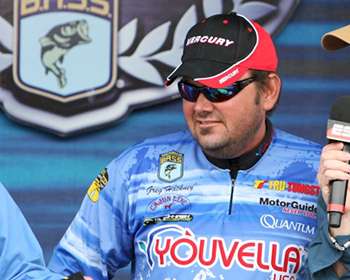
On lakes throughout the country, touring pros are forced to break down hundreds of acres of stumpfields to find the key stretches that hold the most and biggest fish. For example, on Wheeler Lake's famous Decatur Flats, if they don't get to the key spots first, they'll have to stand idly by and watch as their competitors load the livewells.
Accordingly, Greg Hackney has developed strategies to find the sweet spots in the shortest amount of time. Structural differences are the first clues he looks for. "The best thing is if you can find a ditch or some sort of migration route," Hackney says. But if there's no such "highway," he still wants to find pieces to the puzzle.
"There are certain places where the fish move up on big flats, and the first thing I'll always look for is something irregular," Hackney says. "Whether it's a laydown piece of wood, a tree with limbs, or different species of tree — you need to find something different. I'm looking for something visible, and once I find that, it gets me started." A basic knowledge of the local flora is another good piece of background.
Hackney explains that, "If you see a pine tree, that's normally a hump because they tend to grow on higher ground. It helps to know what kind of trees they are so you can tell one from the other." Once he gets a bite, depth is the next variable to consider. "A lot of times you'll have a big flat and it will have slight variations in depth," he says.
"The bass will have a tendency to hold in the areas that are of similar depth, be it in 2 feet or 4 feet of water." If you put together multiple pieces of the puzzle you've got a good starting point, but there's still more to decipher. "You've got to get bit at least one time to key you into what you're looking for," explains the Louisiana pro. "I'm looking for a pattern within a pattern.
I first want to find what kind of stumps the bass are holding on so I'll pick up a square-billed crankbait, spinnerbait or something I can cover a lot of water with and try to get that first bite." Sometimes the variables reflect minute differences.
There may be a few fish in 2 feet of water but none in 2 1/2. They may want a bait presented around cedar stumps in that depth but not oak stumps or willows. The primary way to discern these differences is to cover a lot of water and stay focused. "Put your head down, go fishing and catch the first one," Hackney says. "That should tell you where most of the bass are located."
(Provided by Z3 Media)





